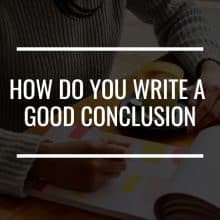

“Writing a good conclusion is easy! You just wrap everything up and list the main points of your article again! That’s it, right?”
Not even close.
You’ve nailed the title, introduction, body, and now you’ve got to nail the conclusion, too, or risk leaving readers hanging in the air. Nothing turns readers off more than inconsistency.
So what does a lazy conclusion look like? I’ve been in your shoes and let me tell you – the first step towards progress is admitting that you have a problem. If you’ve written anything remotely similar to the following, it’s okay. Learn from my mistakes (and the mistakes of countless other successful bloggers).
Here are the things that will take you from a good conclusion to a lazy one really fast.
Even though we learned early in our lives that this is the best way to close essays, you should never do the same with blog posts.
It’s lazy and adds nothing of value to the conversation.
A conclusion is supposed to be a rallying cry to action and simply rehashing everything you just discussed, adding no further context or insight, is a waste of everyone’s time.
It usually looks something like this:
“Here’s an attempt where I barely exerted any effort to restate my main points without directly copying it from the introduction. Although, I might have used a thesaurus to mix things up a little bit. Here was the first point I covered, the second point I covered, and here is the third point I covered. Keep these things in mind as you move forward. Peace.”
Funny, right? This is a really common way to end a blog post because it’s easy.
What you should do: Mention the main points of the post, but don’t let your conclusion focus on them. Ask yourself: “What now?” What action should the reader take now that they’ve read your blog post?
Imagine writing a valuable blog post with a killer introduction and body about how to end a blog post, and the conclusion simply asks: “How about you? What’s your favorite way to end a blog post?”
Some bloggers love to bombard readers with a string of pointless questions as a last-ditch attempt at dodging a decent conclusion altogether.
What you should do: Think about the goal of the blog post. The conclusion should include a call-to-action (CTA) or content offer. If people are truly moved by your content, they will leave comments. Even if they don’t, that’s not necessarily the quality standard for success you should be looking for.
Yes, there are exceptions to every rule, and there are occasions where asking a question to engage comments would work. But unless you’ve got a strategic reason beyond, “I don’t want to write a conclusion, and this is probably a good question to ask,” just don’t.
I’M JOKING! I couldn’t resist…
On a serious note, writing a good conclusion shouldn’t be ignored. Bloggers tend to skimp on writing good conclusions because they think the work they’ve done on the introduction and body is good enough to carry the entire post. Even if that’s true, a conclusion is just as impactful as the rest of your blog post.
Start thinking critically about your conclusions. Review some of the conclusions you’ve previously written and analyze them for areas of improvement.
The more you continuously work to improve your overall writing skills, the more you’ll provide your readers with deep insights — making them consider you as an authority in your niche.
I've been in internet marketing for over 10 years, and I've purchased dozens of illegitimate products for the sole purpose of evaluating them and exposing the truth about these products to anyone who's thinking about purchasing it. I never let money influence my rating of a product and your success/safety is my absolute highest priority. Don't want to buy a product? Register for one of my 100% free internet marketing training courses>>